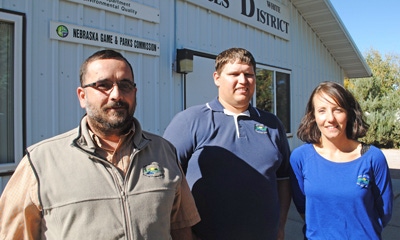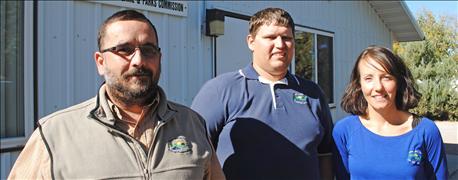
Water is the key to agriculture, especially if you are farming and ranching in the northern Nebraska Panhandle and Pine Ridge. With annual mean precipitation at about 15 inches per year, water is monitored closely within the Upper Niobrara White Natural Resources District, which includes all or part of Sheridan, Dawes, Sioux and Box Butte counties. In fact, the entire NRD has been designated as a Groundwater Management Area since 1990.

REPORT TEAM: Monitoring groundwater supplies is crucial for Pine Ridge irrigators, so a team of technicians from the UNWNRD work to monitor groundwater and report weekly on crop water use across the four-county district. Pictured here are Lynn Webster (left), UNWNRD assistant manager; Nevin Price, resources technician; and Sheri Daniels, conservation programs coordinator.
Since that time, irrigation has become more closely monitored for farmers in the region, says Lynn Webster, UNWNRD assistant manager. Today, nearly 250,000 acres within the NRD boundaries are irrigating a wide range of crops including corn, dry edible beans, sugarbeets, alfalfa, potatoes, sunflowers, wheat and field peas, just to name a few.
Watching water
Webster notes that among the irrigated areas of the NRD, about 191,000 acres are included in higher groundwater management subareas where there are specific irrigation allocations. NRD technicians have been closely monitoring static well-water levels across the district, along with irrigation water use. Although irrigation amounts vary year to year, depending on the weather and precipitation, Webster says that usage has not exploded and, in some years, has actually declined. The UNWNRD board of directors recently approved a new allocation within the subareas of 65 inches over a five-year period. This allows irrigators to more easily plan their crop rotations and projected crop water use over a longer period, so they can incorporate the planting of low water-use crops like field peas, to offset heavier water-use crops like corn across the five-year time period.
Crop water-use report
Sheri Daniels, UNWNRD conservation programs coordinator, started developing a weekly crop water-use report over the summers when she was hired 17 years ago. The weekly reports have become so popular now, that irrigators and other producers will call into the NRD office to get the numbers, Daniels says.
"One of the goals of the reports is to provide producers with additional information to be used in deciding when and how much to irrigate," she says. "These decisions can lead to savings in both water and money."
"We are working with 11 producers who volunteer their information within the irrigation areas," says UNWNRD resources technician and project coordinator, Nevin Price. "They call in with their readings on Monday mornings and the report goes out on Monday afternoons." The weekly reports are sent to several media outlets, including local newspapers and radio stations, as well as through an email list and a weekly post on the NRD website.
"The report information is based on evapotranspiration gauges located in the fields of the cooperators, in combination with an estimate of general crop growth stages across the NRD as well as local precipitation readings," says Price. "We start with the reporting over the Memorial Day weekend and go on through Labor Day weekend." The reports cover the average water use by specific regional crops, as well as lawns and a projected use for the current week. It also includes rainfall across the district and average ET gauge readings for the previous week. In addition, two soil moisture monitoring stations provide information about water availability at varied soil depths, under specific soil types and cropping systems.
While the numbers may not match up perfectly for each grower in the district, Price says they offer a glimpse at real field conditions across the region. "The challenge for me sometimes is to estimate crop growth stages across the district, because the crops are at different stages in different parts of the district depending on weather events," Price says. "I do the best I can to come up with an average that is useful to everyone." Precipitation numbers come from those reported by weather watchers through the Nebraska Rainfall Assessment and Information Network, or NeRAIN project with the Nebraska Department of Natural Resources, he adds.
You can learn more about the weekly crop water use reports by going to unwnrd.org.
About the Author(s)
You May Also Like






